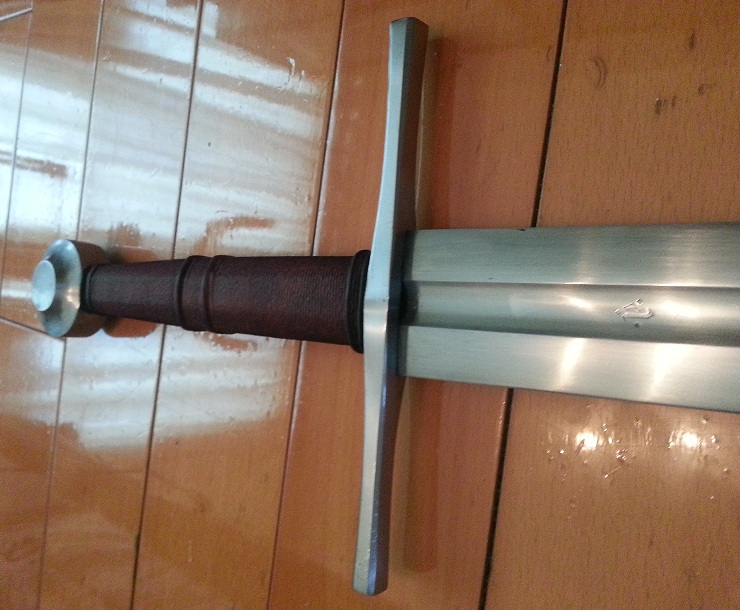Overview
During the 11th and 12th centuries, swords seem to have been nearly exclusively one handed weapons, used paired with a kite shield. By about the 13th century, swords with longer grips start to appear, and these swords represent the first foray by medieval smiths in the art of crafting longer “great swords”. While single handed swords still appear to have dominated throughout the century, by the second half of the 13th century, great swords become more common, reaching their height in the first half of the 14th century. At a time when knights, men-at-arms and other warriors of means wore full suits of mail, with perhaps some minor reinforcements made of plate and the distinctive great helms and early bascinets, these larger swords represented the apogee of cleaving and hewing weapons, eschewing the narrower blades of Type XV swords and their ilk.
One such sword, XIIIa.5 from Records of the Medieval Sword, was discovered only comparatively recently in Linz, Austria, having been hidden in a house for centuries. It was this sword that served as the primary inspiration for Albion's Next Generation Steward, and the two are fairly close. The main differences between them is that the Steward has a peen block whereas the Linz sword does not, and the grip of the Steward is a little bit longer. Additionally, the fuller on the Linz sword seems to extend along just under half of the blade, while the Steward's extends along two thirds of the blade. The Linz blade may also have a somewhat wider point section, but this is difficult to judge from photos alone.
Specifications (from Albion's website)
Total Length: 43.69” (111 cm.)
Blade Length: 34.87” (88.6 cm.)
Blade Width: 1.93” (4.9 cm)
CoB: 4.5” (11.43 cm.)
CoP: 23.25” (59 cm.)
Weight: 2 lbs 14 ounces (1.3 kg)
Fit and Finish
Everything here is on par with Albion's usual good quality. The seam on the leather grip blends quite well with the rest of the leather, and is mostly straight. The cross fits extremely well around the blade with almost no gaps whatsoever. As for the fuller, it is crisp and has the nicely tapered “fade” at the far end that makes Albion swords a cut above many of their competitors. The finish looks pretty consistent across the blade, with no obvious machine marks. This particular sword did not seem to have any pitting that I could see.
After taking this sword out and handling it for a bit and then leaving it for a few days, some rust developed on the pommel; this was entirely my fault for not having oiled the sword soon enough in a high humidity environment. I did my best to remove the rust with sandpaper, but any discolouration or blemishes seen on the pommel in these photos is not indicative of any fault or inadequate preparation to ship the sword on the part of Albion.
Handling
The first thing that I noticed upon picking up this sword was that its hilt area is quite hefty. There's a fair amount of mass, so the static weight of the sword in hand is appreciable. But when you strike with the sword, the balance suddenly makes perfect sense: the blade itself feels like it has very little mass, so that it feels quite light and lively in hand. “Agile” is a word that Albion uses to describe this sword and it's well chosen; the sword floats through the air, like a Brescia Spadona with greater blade presence.
The grip itself has eight planes, making it thicker in size. It does feel a little “blocky” in hand, more so than some of the other Albion swords. For someone with large hands, this will undoubtedly be a plus, and for someone with medium sized hands like me, the grip feels just fine in hand once you've adjusted from handling other grips. However, for someone with smaller hands, this may not be the sword of choice. The size and shape of the grip will probably make it less comfortable than many other Albion swords, particularly when compared with some of the more slender long swords.
The point on the Steward is quite rounded. While all swords are capable of delivering powerful thrusts if used effectively, the Steward's point obviously will have trouble driving through mail the way a Type XVa blade might. Unsurprisingly, this sword is not particularly well suited for harnischefechten, and it's noteworthy that the heyday of XIIIa swords seems to have largely passed by the time full plate makes its appearance, at least when compared with the number of blades of Type XVa, XVII, XVIIIa, XVIIIb, or XVIIIc that appear in period art from the late 14th century and into the 15th century.
Conclusion
The Steward is an absolutely classic great sword that perfectly matches those found in contemporary period art. If you're looking for a great sword, it's hard to go wrong with the Steward. Although it might not have the flash and extra elegance of a sword like the Count, the Steward beautifully captures the working, utilitarian beauty that so characterizes many medieval swords.

[ Download ]
[ Download ]
[ Download ]
[ Download ]